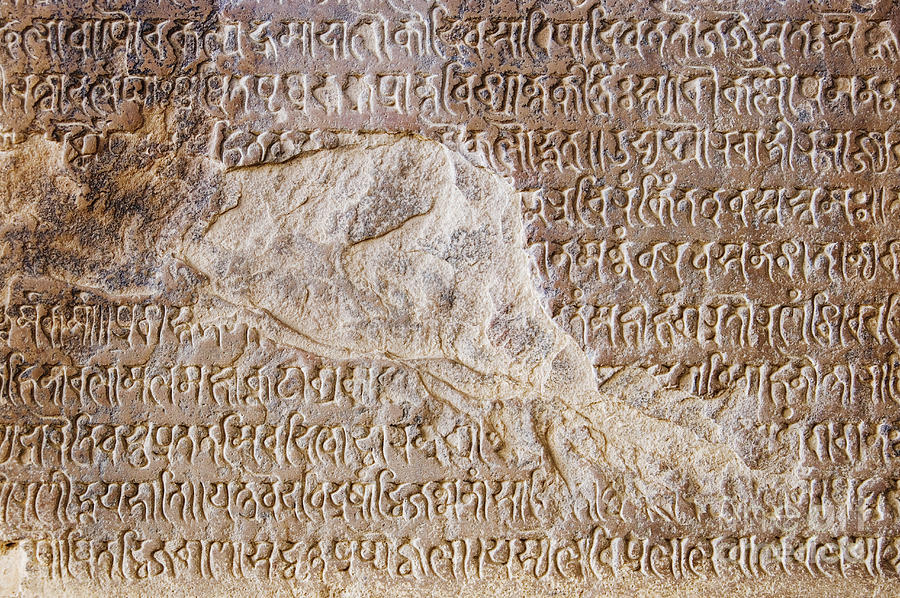MRI scans show that memorizing ancient mantras increases the size of brain regions associated with cognitive function.

Ancient Sanskrit on wall at the Khajuraho
I witnessed a hundred dhoti-clad young men sat cross-legged on the floor in facing rows, chatting amongst themselves in an opening ceremony of a temple. At a sign from their teacher, the hall went quiet. Then they began the recitation. Without pause or error, entirely from memory, one side of the room intoned one line of the text, then the other side of the room answered with the next line. Bass and baritone voices filled the hall with sonorous prosody, every word distinctly heard, their right arms moving together to mark pitch and accent. The effect was hypnotic, the ancient sound reverberating through the room, saturating brain and body. After 20 minutes they halted, in unison. It was just a demonstration. The full recitation of one of India´s most ancient Sanskrit texts, the Shukla Yajurveda, takes six hours.
Such Sanskrit mantra we have seen more than one time at least in our life, but thought it a usual chore of Indian religious culture. But never wondered what was hidden behind these words’ vibration?
I spent many years studying and translating Sanskrit, as a subject but never mastered it and sooner the environment of school was not welcoming towards Sanskrit as we all are aware of it now. In India’s ancient learning methods textual memorization is standard: traditional scholars, or pundits, master many different types of Sanskrit poetry and prose texts; and the tradition holds that exactly memorizing and reciting the ancient words and phrases, known as mantras. Now a study proves that it actually enhances both memory and thinking. Ah! So that was the reason why the ancient text is still alive but now we can save them digitally. So, there must be some degradation in memorizing and thinking capability after the twilight of the Sanskrit era. Dementia and Alzheimer’s are catching at an early age of 60 or before that too. We can give Sanskrit a chance for the prevention of such diseases, such diseases are not chronic but are the recent one. Description of such diseases isn’t mentioned in any of the ancient text because they were unaware of it, even we never heard about them in stories of our grandma or great grandma.
Here is a story of a person, who like me was passionate about this language. He carried out first of its experiment on the Indian Sanskrit scholars, James Hartzell says “I had also noticed that the more Sanskrit I studied and translated, the better my verbal memory seemed to become. Fellow students and teachers often remarked on my ability to exactly repeat lecturers’ own sentences when asking them questions in class. Other translators of Sanskrit told me of similar cognitive shifts. So I was curious: was there actually a language-specific “Sanskrit effect” as claimed by the tradition?”
India’s Vedic Sanskrit pundits train for years to orally memorize and exactly recite 3,000-year old oral texts ranging from 40,000 to over 100,000 words. So, he was interested to know that how such intense verbal memory training affects the physical structure of their brains. They used structural magnetic resonance imaging (MRI) at India’s National Brain Research Center to scan the brains of pundits and controls matched for age, gender, handedness, eye-dominance, and multilingualism.
What they discovered from the structural MRI scanning was remarkable. Numerous regions in the brains of the pundits were dramatically larger than those of controls, with over 10 percent more grey matter across both cerebral hemispheres, and substantial increases in cortical thickness. Although the exact cellular underpinnings of gray matter and cortical thickness measures are still under investigation, increases in these metrics consistently correlate with enhanced cognitive function.
Most interestingly for verbal memory was that the pundits’ right hippocampus—a region of the brain that plays a vital role in both short and long-term memory—had more gray matter than controls across nearly 75 percent of this subcortical structure. Our brains have two hippocampi, one on the left and one on the right, and without them, we cannot record any new information. Many memory functions are shared by the two hippocampi. The right is, however, more specialized for patterns, whether sound, spatial or visual, so the large gray matter increases we found in the pundits’ right hippocampus made sense: accurate recitation requires highly precise sound pattern encoding and reproduction. The pundits also showed substantially thickening of right temporal cortex regions that are associated with speech prosody and voice identity.
Now, it would be wrong to say that Sanskrit is obsolete because it heavenly affects our brain.
Subscribe for more such interesting reports
